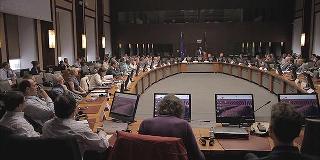May 20 2015
The world's experts in nuclear explosion monitoring teamed up with pharmaceutical producers from across the globe in Brussels, Belgium, from 12 to 14 May 2015, to address a growing challenge to nuclear test monitoring.
 The world's experts in nuclear explosion monitoring teamed up with pharmaceutical producers from across the globe in Brussels, Belgium, from May 12-14, 2015, to address a growing challenge to nuclear test monitoring. Credit: CTBTO
The world's experts in nuclear explosion monitoring teamed up with pharmaceutical producers from across the globe in Brussels, Belgium, from May 12-14, 2015, to address a growing challenge to nuclear test monitoring. Credit: CTBTO
Going into the workshop, six producers of medical isotopes had so far pledged to work with the Comprehensive Nuclear Test Ban Treaty Organization (CTBTO) in addressing the issue. But by the end of the workshop, 10 companies had vowed to reduce emissions or bring xenon emissions to zero, and share their data to increase confidence in nuclear test monitoring.
"We are looking for very small sniffs of xenon. And those small sniffs can be buried under a background of emissions that could come from medical isotope producers. And our aim is to see how we can understand each other, understand the emissions, control the emissions but not control the production," CTBTO Executive Secretary Lassina Zerbo said.
Medical isotope production creates lifesaving diagnostic and cancer treatments. But at the same time, the noble gas xenon transmitted from manufacturing plants is interfering with the CTBTO's monitoring work. Such emissions may mask a potential release of this noble gas from an underground nuclear test as the gas emitted is identical. The CTBTO uses a global network of ultra-sensitive detectors to pick up the radioactive noble gas xenon. In order to save lives now and in the future, both producers and nuclear-test-ban monitors came together to find solutions without impacting production.
"Radioxenon emissions stemming from medical isotope production sites can interfere with the capacity of the International Monitoring System to detect nuclear explosions. And therefore the SCK-CEN and the Institute for Radioelements (IRE) are studying possible options to mitigate those radioxenon emissions, Belgium's Director General for Energy," Nancy Mahieu said.
In Indonesia, work has already begun with isotope producer, PT Inuki, which has joined with the CTBTO to reduce emissions. "We think that our experience over the last three years is not that expensive. If we are willing to do it, if we are willing to help the international community putting a ban on nuclear weapons and monitoring, it does not cost a lot of money. I am a nuclear engineer. I agree with the nuclear technology for peaceful uses. I don't agree with weapons of mass destruction like nuclear weapons. So we have to use this in a right way," Yudiutomo Imardjoko, PT INUKI, Indonesia said.
The low levels emitted from the isotope production industry are not harmful to human health or the environment but may be high enough to trigger the CTBTO's sensitive alarms. One way of mitigating these effects is to reduce the emissions.
"At the moment, the driver is to produce the radioisotopes and help people. The emissions are not causing problems to the environment or the public so there is no driver to reduce apart from the impact on IMS stations," Emma Hoffman, Australian Nuclear Science and Technology Organisation (ANSTO) said.
Some 100 experts from every continent attended the Workshop on Signatures of Medical and Industrial Isotope Production. On the agenda was a presentation on a new technology to capture noble gas emissions directly at production facilities using a small versatile system. It is being developed by Belgium's nuclear research institute, SCK-CEN, under contract with the CTBTO and funded by the European Union. After success in the lab, industrial tests are beginning in June.
"IRE is working on a project which has been financed by the European community, with the CTBTO, in which we are going to try a new type of material which can trap the xenon in order to reduce the releases," Benoit Deconninck, IRE said.
"The new technologies are going to allow us to assist the CTBTO in keeping xenon emissions low, and so reducing impact on their network as well as allowing us to actually be able to do it in a cost-effective way. So it is a real game changer," said Emma Hoffman, ANSTO.
The European Union has also funded a global measuring campaign on background levels of radioxenon emissions at different locations. "It is not a local issue, it is a global issue," said Jun Sig Lee, KAERI, Republic of Korea. A lot of people actually want to have a world without nuclear bombs. Also a lot of people need medical isotopes. In that sense, the international community tries to minimize the xenon emissions.
"We and medical isotope production people are doing essentially the same job," said Ted Bowyer, Pacific Northwest National Laboratory (PNNL), USA. "We are trying to save lives in very different ways. There are many ways to do that. The easier one to imagine is production of isotopes given to a patient when a diagnostic procedure occurs, maybe that day or the next day. For us it is a longer term problem. We are trying to save lives by deterring nuclear testing and deterring nuclear threats from countries. Samesort of thing. Much longer timeframe problem that we are working on," Bowyer said.
The six producers of medical isotopes who have already signed the pledge to work with the CTBTO to mitigate emmisions are:
- Korea Atomic Energy Research Institute (KAERI)
- PT INUKI, Indonesia
- Coquí RadioPharmaceuticals Corp, United States
- Institute for Radioelements (IRE), Belgium
- Australian Nuclear Science and Technology Organisation (ANSTO)
- NorthStar Medical RadioIsotopes, United States
Emma Hoffman, ANSTO, Australia, was awarded the Wozzie Award -- sponsored by PNNL -- for outstanding efforts to mitigate radioxenon emissions.
The meeting was co-organized by SCK-CEN Belgian Nuclear Research Centre and PNNL in association with the CTBTO.